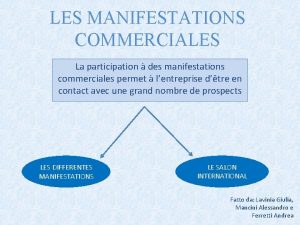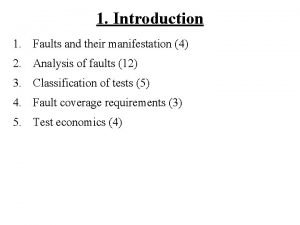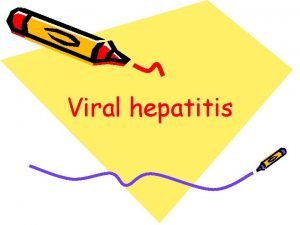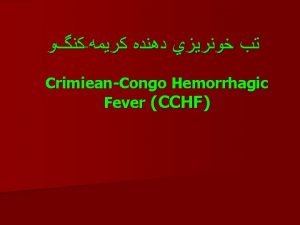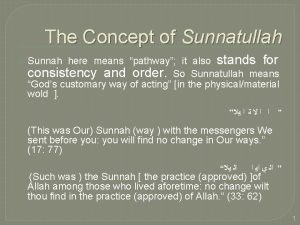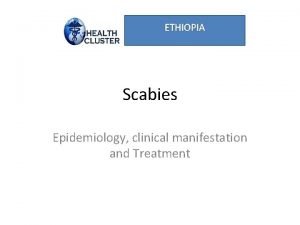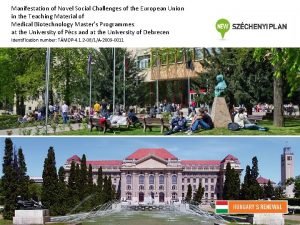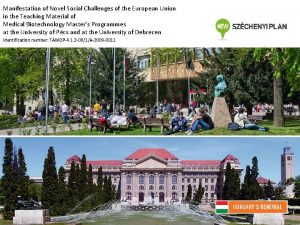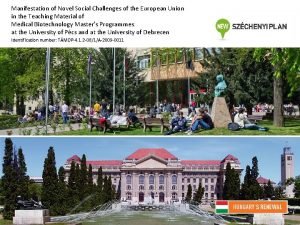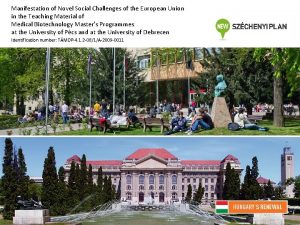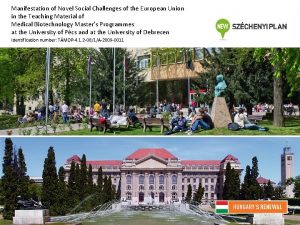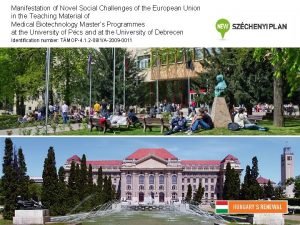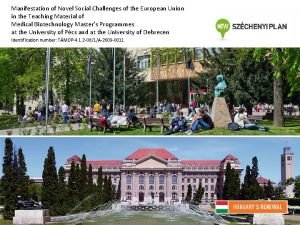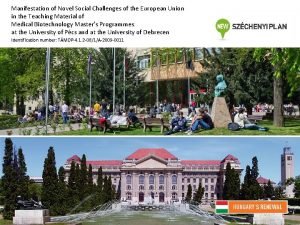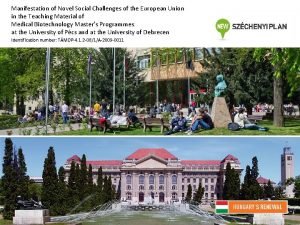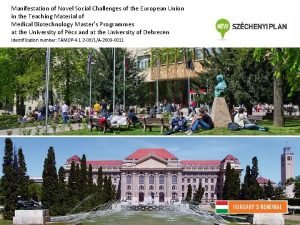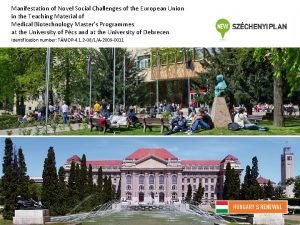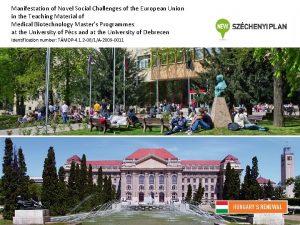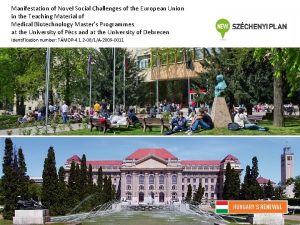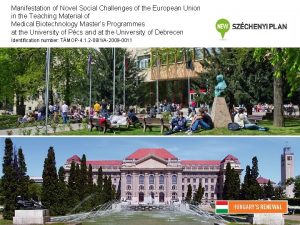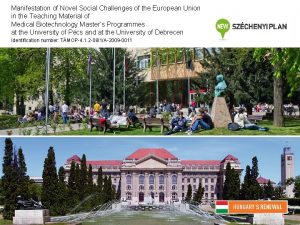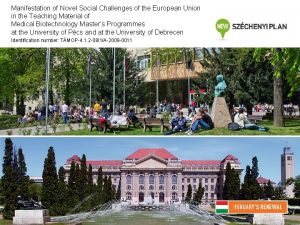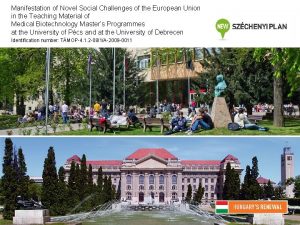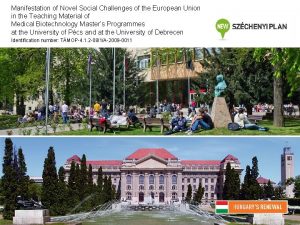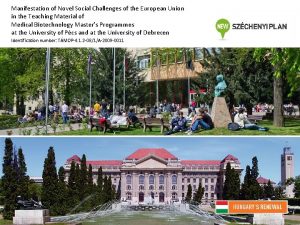Manifestation of Novel Social Challenges of the European





















- Slides: 21

Manifestation of Novel Social Challenges of the European Union in the Teaching Material of Medical Biotechnology Master’s Programmes at the University of Pécs and at the University of Debrecen Identification number: TÁMOP-4. 1. 2 -08/1/A-2009 -0011

Manifestation of Novel Social Challenges of the European Union in the Teaching Material of Medical Biotechnology Master’s Programmes at the University of Pécs and at the University of Debrecen Identification number: TÁMOP-4. 1. 2 -08/1/A-2009 -0011 Krisztián Kvell Molecular and Clinical Basics of Gerontology – Lecture 27 CANCER AND TUMOR DEVELOPMENT – SENESCENCE AND CANCER, EPIDEMIOLOGY AND STATISTICS

TÁMOP-4. 1. 2 -08/1/A-2009 -0011 DNA damage-triggered cell fate responses Exogenous Effects DNA Damage Endogenous Effects p 53 Transcription of Candidate Genes Cell cycle-stop Oxidative Stress Apoptosis DNA Repair Differentation Angiogenesis

TÁMOP-4. 1. 2 -08/1/A-2009 -0011 Tumor suppressor genes • Caretakers First line of defense, prevent genomic oncogenic mutations to occur • Gatekeepers Second line of defense, eliminate (by apoptosis) or senesce cells with oncogenic mutations

TÁMOP-4. 1. 2 -08/1/A-2009 -0011 Molecular level senescence pathways Human Culture stress Mouse Common Telomere shortening RAS p 53 p 16 p 38 p 21 RB ROS Senescence

TÁMOP-4. 1. 2 -08/1/A-2009 -0011 Molecular level cell fate decisions Active Fox. O Proteins SIRT 1 p 300 AC CBP Fox. O p 27 Nuclear translocation c-Myc NF-k. B Fas L Noxa Bim TRAIL p 53 Mito Anti-inflammation Cell cycle arrest P Akt JNK P 14 -3 -3 Caspase-1 Cancer inhibition PS exposure Cell DNA cleavage P 14 -3 -3 Cytc Caspase-3 Fox. O Inflammatory cell activity Cytoplasmic localization Ubiquitination and degradation of Fox. O Apoptosis blockade

TÁMOP-4. 1. 2 -08/1/A-2009 -0011 p 53 has ambivalent talents I • p 53 as major tumor suppressor gene - Potent inducer of apoptosis, cell cycle arrest, senescence - 50% of sporadic malignancies share loss or mutation of p 53 gene - 80% of all human cancers have dysfunctional p 53 signaling - Heterozygous human p 53 KO (Li-Fraumeni syndrome) have high cancer incidence (50% by 30 y)

TÁMOP-4. 1. 2 -08/1/A-2009 -0011 p 53 has ambivalent talents II • p 53 as pro-aging factor - Increased p 53 activity leads to signs of accelerated, even premature aging - Beyond age 60 -80 y cancer incidence drops and proaging characteristics dominate - Signal transduction crossover with IGF-1 and m. TOR signaling, explains effects on longevity - p 53 dosage has profound effects on stem cell proliferation and regenerative capacity in the aged

Cancer stem cells escape routine elimination TÁMOP-4. 1. 2 -08/1/A-2009 -0011 Polycomb group proteins Oncogenic hits TSGs Apoptosis Senescence Oncogenic hits Differentation: restricted growth Differentation: acquisition of self-renewal potential Polycomb group proteins Benign cancer cells with limited proliferative potential Malignant cancer stem cell Heterogeneous malignant stem cell tumour

TÁMOP-4. 1. 2 -08/1/A-2009 -0011 Malignant tumor escape mechanisms I Apoptosis Senescence MYC Therapy ARF p 53 Bcl-x. L Apoptosis defect Normal cells Tumour INK 4 A Senescence defect Apoptosis Senescence RAS Drug-resistant tumour Therapy INK 4 A Normal cells Senescence defect p 53 Tumour Apoptosis Oncogene TP 53 mutation Apoptosis defect Drug-resistant tumour Therapy p 53 Normal cells TP 53 mutation Failsafe defect Tumour Drug-resistant tumour

TÁMOP-4. 1. 2 -08/1/A-2009 -0011 Malignant tumor escape mechanisms II Malignant population Therapy (DNA damage) ? ? Senescence induction Apoptotic cell death ? Terminal arrest Immune attraction Beneficial ? ? Growth promotion Detrimental Escape

p 53 polymorphisms in cancer and longevity TÁMOP-4. 1. 2 -08/1/A-2009 -0011 • Codon 72, proline → arginine, (evolutionarily late SNP), higher apoptotic efficiency • Mdm 2 gene, G allele means more supression and more cancer compared to T allele • Combination of G/G, Pro/Pro, smoker means >10× odds for cancer (gene + environment) • >85 y Pro/Pro means 40% in survival despite 2. 5× odds for cancer

TÁMOP-4. 1. 2 -08/1/A-2009 -0011 Antagonistic pleitropy: p 53 and p 16 • Senescence responses suppress tumors • Senescence-inducers are also oncogenic • Cancers share mutations in p 53 or p 16 • Loss of senescence response = tumor • Classical trade-off relation

TÁMOP-4. 1. 2 -08/1/A-2009 -0011 Cancer development and telomeres Constant increased recruitment of stem cells into cell cycle TERT TERC Telomerase complex DKC 1 Short telomeres Cell cycle arrest/cell death of progenitor cells Genomic instability MDS/AML Cancer

TÁMOP-4. 1. 2 -08/1/A-2009 -0011 Acquiring immortality via telomerase Express TERT Spontaneous telomere stabilization Divisions RB and p 53 inactivation Divisions Senescence Telomere shortening Crisis Immortality Telomere maintenance

Antagonistic pleiotropy: telomere length I TÁMOP-4. 1. 2 -08/1/A-2009 -0011 • Mouse telomeres are extremely long • Mouse tissues often express telomerase • Mouse cultured cells ‘spontaneously immortalize’ • Human telomeres are much shorter • Most human tissues lack telomerase • Human cultured cell immortalization is zero

Antagonistic pleiotropy: telomere length II TÁMOP-4. 1. 2 -08/1/A-2009 -0011 • Rodent strategy: high annual mortality, low chances of cancer development = long telomeres, active telomerase to fight ROS • Primate strategy: low annual mortality, elevated chances of tumors = short telomeres, lack of telomerase to fight cancer

TÁMOP-4. 1. 2 -08/1/A-2009 -0011 Acetylation status and epigenetic silencing I Transcription K 4 HMT HAT CO-ACT TAF TF TBP RNA-PII Epigenetic silencing CAF-1 DNMT 1 MBD HP 1 MBD K 9 HMT HDAC CO-REP Acetylated histone tails Methylated hystone tails Methylated DNA (Cp. G dinucleotides)

TÁMOP-4. 1. 2 -08/1/A-2009 -0011 Acetylation status and epigenetic silencing II Euchromatin Cdk 2 p 300 Cyc E P Transcription of cyc E and other growthpromoting genes E 2 F site p 300/CBP Heterochromatin DNMT 1? RB E 2 F Stable repression of cyc E and other growth-promoting genes HDAC E 2 F site SUV 39 H 1 HP 1? Acetylated histone tails Deacetylated hystone tails Methylated histone tails

TÁMOP-4. 1. 2 -08/1/A-2009 -0011 Cancer epidemiology worldwide

TÁMOP-4. 1. 2 -08/1/A-2009 -0011 Cancer statistics • 13 million cancers every year, 8 million deaths • Most frequent cancer types: - Lung cancer - Stomach cancer - Colorectal cancer - Liver cancer - Breast cancer • Most patients are aged 65+ years - 1/3 person has thyroid cancer at autopsy - 4/5 men have prostate cancer by 80 years of age
 New drug delivery system
New drug delivery system Les sentiments de joie
Les sentiments de joie Manifestation commerciale exemple
Manifestation commerciale exemple Manifestation determination meeting agenda
Manifestation determination meeting agenda Canvas.aps
Canvas.aps Manifestation determination flowchart
Manifestation determination flowchart Rayon rubis doré
Rayon rubis doré The manifestation of the holy spirit
The manifestation of the holy spirit Concept de virginia henderson
Concept de virginia henderson Manifestation determination definition
Manifestation determination definition Fault is manifestation of which defects
Fault is manifestation of which defects Manifestation names
Manifestation names Clinical manifestation of hepatitis
Clinical manifestation of hepatitis Manifestation names
Manifestation names Clinical manifestation of epistaxis
Clinical manifestation of epistaxis Vocabulaire manifestation
Vocabulaire manifestation How sunnatullah manifested in the universe and human life
How sunnatullah manifested in the universe and human life Friday manifestation
Friday manifestation Bbl lotion for scabies
Bbl lotion for scabies Social thinking and social influence in psychology
Social thinking and social influence in psychology Social thinking social influence social relations
Social thinking social influence social relations Social challenges
Social challenges


